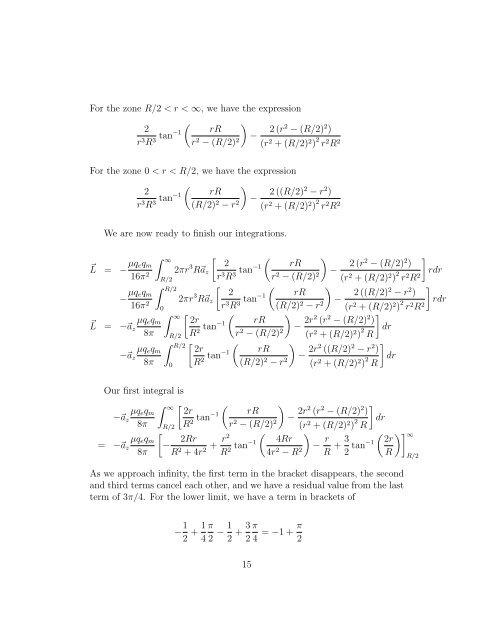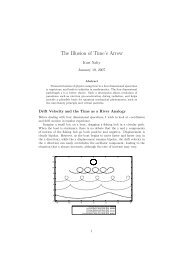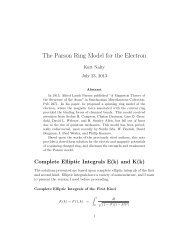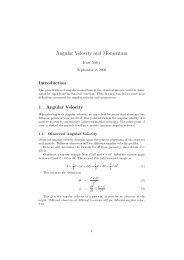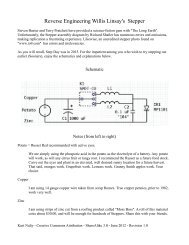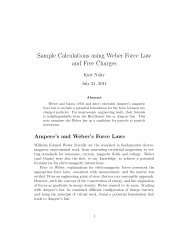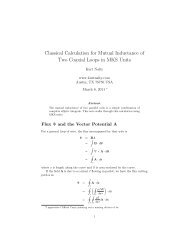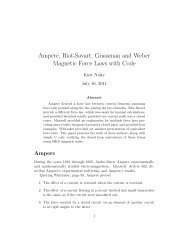Exercises with Magnetic Monopoles - Kurt Nalty
Exercises with Magnetic Monopoles - Kurt Nalty
Exercises with Magnetic Monopoles - Kurt Nalty
Create successful ePaper yourself
Turn your PDF publications into a flip-book with our unique Google optimized e-Paper software.
For the zone R/2 < r < ∞, we have the expression<br />
(<br />
)<br />
2<br />
rR<br />
r 3 R 3 tan−1 − 2 (r2 − (R/2) 2 )<br />
r 2 − (R/2) 2 (r 2 + (R/2) 2 ) 2 r 2 R 2<br />
For the zone 0 < r < R/2, we have the expression<br />
(<br />
)<br />
2<br />
rR<br />
r 3 R 3 tan−1 − 2 ((R/2)2 − r 2 )<br />
(R/2) 2 − r 2 (r 2 + (R/2) 2 ) 2 r 2 R 2<br />
We are now ready to finish our integrations.<br />
⃗L = − µq ∫ ∞<br />
[ (<br />
)<br />
eq m<br />
2<br />
2πr 3 rR<br />
R⃗a<br />
16π 2<br />
z<br />
R/2 r 3 R 3 tan−1 − 2 ]<br />
(r2 − (R/2) 2 )<br />
r 2 − (R/2) 2 (r 2 + (R/2) 2 ) 2 rdr<br />
r 2 R 2<br />
− µq ∫ R/2<br />
[ (<br />
)<br />
eq m<br />
2<br />
2πr 3 rR<br />
R⃗a<br />
16π 2 z<br />
0<br />
r 3 R 3 tan−1 − 2 ]<br />
((R/2)2 − r 2 )<br />
(R/2) 2 − r 2 (r 2 + (R/2) 2 ) 2 rdr<br />
r 2 R<br />
∫ 2<br />
µq e q ∞<br />
[ (<br />
)<br />
]<br />
m 2r<br />
rR<br />
⃗L = −⃗a z<br />
8π R/2 R 2 tan−1 − 2r2 (r 2 − (R/2) 2 )<br />
r 2 − (R/2) 2 (r 2 + (R/2) 2 ) 2 dr<br />
R<br />
∫<br />
µq e q R/2<br />
[ (<br />
)<br />
]<br />
m 2r<br />
rR<br />
−⃗a z<br />
8π R 2 tan−1 − 2r2 ((R/2) 2 − r 2 )<br />
(R/2) 2 − r 2 (r 2 + (R/2) 2 ) 2 dr<br />
R<br />
0<br />
Our first integral is<br />
∫<br />
µq e q ∞<br />
[ (<br />
)<br />
m 2r<br />
rR<br />
−⃗a z<br />
8π R/2 R 2 tan−1 r 2 − (R/2) 2<br />
[<br />
µq e q m<br />
= −⃗a z −<br />
2Rr<br />
( )<br />
8π R 2 + 4r + r2 4Rr<br />
2 R 2 tan−1 4r 2 − R 2<br />
]<br />
− 2r2 (r 2 − (R/2) 2 )<br />
(r 2 + (R/2) 2 ) 2 dr<br />
R<br />
− r R + 3 2 tan−1 ( 2r<br />
R<br />
)] ∞<br />
R/2<br />
As we approach infinity, the first term in the bracket disappears, the second<br />
and third terms cancel each other, and we have a residual value from the last<br />
term of 3π/4. For the lower limit, we have a term in brackets of<br />
− 1 2 + 1 π<br />
4 2 − 1 2 + 3 π<br />
2 4 = −1 + π 2<br />
15


